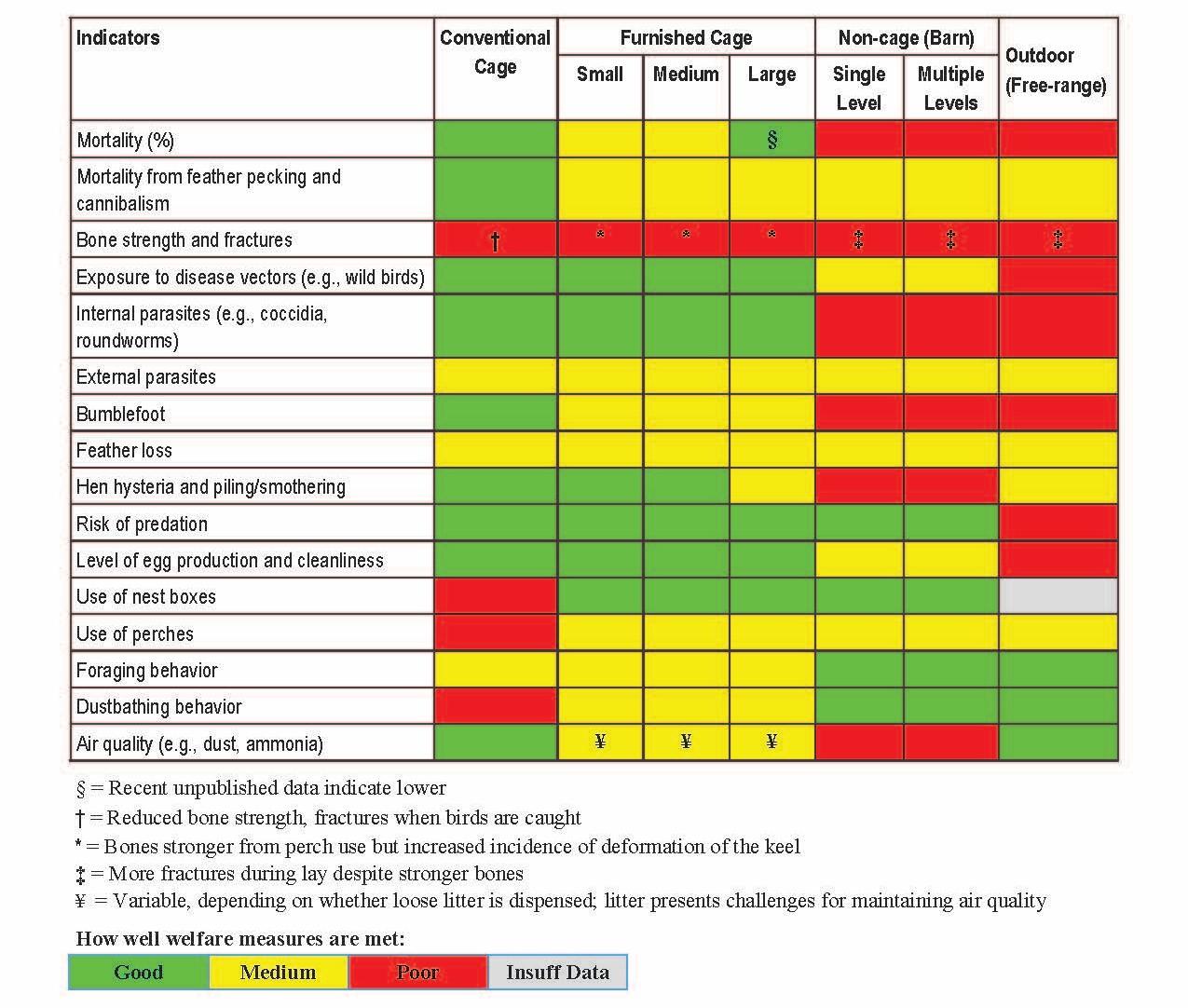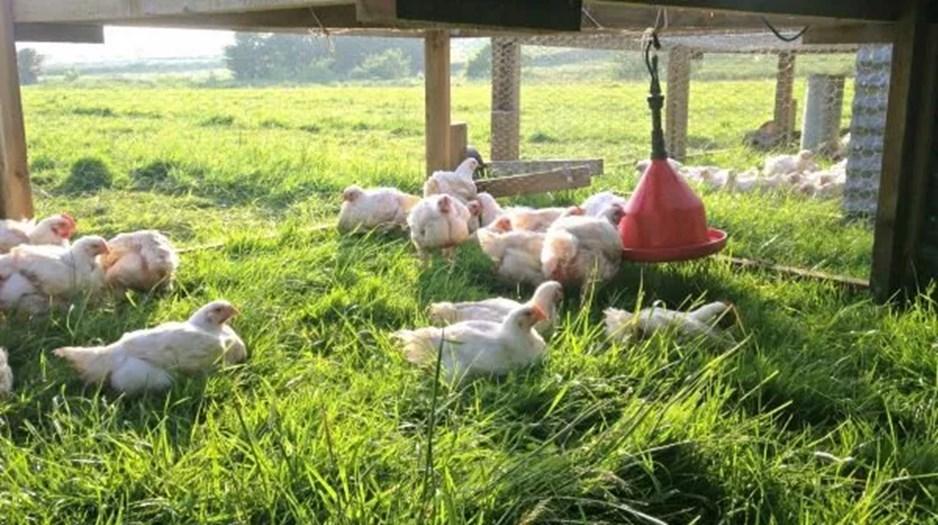
FS-1136 | September 2020
Animal Welfare is Essential to the Sustainability of the Poultry Industry

Sustainability is “the ability to be maintained at a certain rate or level.” In other words, systems must operate to meet the current population’s needs without compromising the ability of future generations to meet their needs. In the past, sustainable systems were those that minimized the depletion of resources or contaminant emissions that were harmful to the environment. Today sustainability has a much broader application and systems are unsustainable if the public finds any effect of the system on the environment, human health, or animal welfare to be unacceptable (Broom, 2019).
Which factors the public considers more important than others, and the order of their importance, varies over time (Broom, 2019). Farm animal welfare is one factor that remains important to the public and the animal agriculture industry. Some actions that improve animal welfare also have positive impacts on the environment and human health, but not always.
The freedom that farmers once had to raise animals as they saw fit has vanished by public demand. The public, particularly consumers and animal activists, drive the dynamics of change in how livestock and poultry are raised in the United States. Sustainable animal producers adopt husbandry practices and housing facilities that are acceptable to the public. However, there can be discrepancies between public perception and the actual welfare conditions of production systems that are often considered more sustainable or welfare-friendly than others.
This Extension bulletin provides an understanding of sustainable animal welfare, why science is the foundation of on-farm animal welfare assessments, and why the growing number of cage-free and organic poultry farms require additional care and management to maintain sustainable animal welfare.
Animal Welfare Assessments Assure Consumers that Production Systems Follow Industry Standards
Animal welfare can be defined as “the quality of life as perceived by the animal” (Bracke and Hopster, 2006). Animal welfare assessments provide the public with assurance that the food products they consume come from production systems where the animals are monitored and evaluated according to a producer organization’s published standards. On-farm animal welfare assessments are centered on maintaining compliance with standards for raising animals (Weimer et al., 2018) by evaluating the impacts of resource and animal management practices on the health and emotions of the animals. For poultry, animal welfare guidelines are published by the National Chicken Council (NCC), National Turkey Federation (NTF), and United Egg Producers (UEP).
The specifications within each animal assessment criteria are science-based and are regularly reviewed and updated according to recommendations from animal welfare science experts. The results from research assessing and validating applications for advanced technologies and practices for improving animal housing, husbandry, transport, and slaughter are incorporated into welfare assessment criteria. Animal welfare assessment criteria are categorized within the areas of recordkeeping, caretaker training, nutrition, emergency response, and most important to this bulletin, housing facilities and animal health and behavior.
The remainder of this bulletin will focus on the increasing market share of poultry products from chickens raised in two alternative poultry hens and broilers)—and important considerations for managing animal husbandry and welfare within each housing system.systems—cage-free (laying hens) and organic outdoor-access (laying hens and broilers)—and important considerations for managing animal husbandry and welfare within each housing system.
More U.S. States, Retailers, and Restaurants are Going Cage-Free
The negative public perception and media attention on the welfare of laying hens raised in conventional (battery) cage housing has led some egg producers to shift from conventional to alternative cage-free housing. Currently, 76% of the eggs produced in the U.S. come from laying hens raised in conventional housing, while 24% are produced in alternative cage-free (18%) or organic (6%) housing (UEP, 2020a).
Public demand for cage-free eggs has already led to several large-scale chain restaurants, such as Starbucks, Wendy’s, Subway, and Burger King, to exclusively serve cage-free eggs to their customers. Walmart and McDonald’s have announced commitments to source 100% cage-free eggs by 2025 (Walmart, 2016, McDonald’s, 2019). The production and sales of eggs from hens raised in conventional cages are banned in California and Massachusetts and will be banned in Washington and Oregon by 2024 and in Arizona, Michigan, and Colorado by 2025. However, cage-free housing facilities are less controllable and require more management, so knowledge and technical skills are crucial in managing welfare issues.
Cage-Free Housing Designs Should be Carefully Considered
Conventionally housed laying hens are raised in groups of 6-7 hens in cages that are stacked together in rows. Alternative, cage-free housing facilities provide more space per hen, allow hens to roam vertically and horizontally, and are equipped with environmental enrichments for hens to express natural behaviors such as perching, scratching, and dust bathing. For more information on the housing details of conventional and cage-free facilities, visit the UEP website (UEP, 2020b).
Compared to alternative systems, conventional laying hen systems house hens in smaller groups, with less space allowance, and do not have enrichments for hens to express natural behaviors. However, they are easier to clean and manage individual hen health. Cage-free and outdoor housing facilities have more space and enrichments, yet may cause health concerns by increasing the incidences of infection, injury, and mortality. Depending on skeletal integrity, keel bone damage can occur when laying hens fall or collide while navigating horizontally or vertically within the housing facilities, especially in cage-free aviaries (Stratmann et al., 2015, Figure 1). While much progress has been made in the past few years, there is still a need for more research to identify the most suitable housing for laying hens.
In Table 1, the American Veterinary Medical Association (AVMA) illustrates the advantages and disadvantages of conventional, cage-free, and outdoor housing facilities on key indicators of laying hen welfare.
Organic Poultry Production Systems Require More Management
The growth of the organic food market continues to increase and poultry is one of the top-selling organic products. From 2017 to 2018, revenue from organic sales increased 7% for eggs and 11% for fresh chicken sales (Nielsen, 2018). USDA-certified organic animal production is often grouped in with sustainability, which may lead consumers to think that animals raised organically automatically have better welfare.

Source: American Veterinary Medical Association summary of the Laywel Final Report (https://www.avma.org/resources/ animal-health-welfare/avma-issues-comparison-cage-and-non-cage-systems-housing-laying-hens)

The USDA’s National Organic Program (NOP) husbandry practices focus on housing systems that provide outdoor access, to promote natural behaviors, restricted use of antibiotics and vaccines for preventative health management, and organic feed (Fanatico et al., 2009). While many organic poultry systems allow opportunities to maintain higher welfare standards, maintaining good health and welfare on organic poultry farms can be challenging. This means that that, just like cage-free laying hen housing systems, husbandry knowledge and technical skills are essential to prevent and correct animal welfare issues.
In a review written by Van De Weerd and colleagues (2009), the key health-related welfare issues in organic poultry production are summarized into three major challenges:
- Management of birds in outdoor systems: Laying hens and broilers raised under the NOP must have access to the outdoors (Figure 2). Chickens may brood entirely indoors until they are 4 weeks old. The NOP does not currently specify indoor or outdoor space requirements. Outdoor access exposes poultry to additional sources of disease and predation and can increase incidence of infection, injury, and mortality.
- Limited use of conventional preventative medication for vaccination and disease treatment: No antibiotics or ionophores (non-human antibiotics) can be administered to organic poultry. The largest issue facing the organic broiler and turkey industry is related to intestinal health; more specifically, the prevention and control of coccidiosis and necrotic enteritis. The NOP mandates that antibiotics must be administered to sick birds but antibiotic-treated birds cannot be sold as organic and must be diverted to nonorganic markets. Some organic poultry producers do not have access to nonorganic markets and may withhold the treatment of sick birds.
- Quality and availability of organic feed: Organic feed is 2-3 times the cost of non-organic feed because organic feed ingredients are limited in supply. The nutrient content and quality of feed ingredients can vary and synthetic amino acids are prohibited (except a limited amount synthetic methionine is allowed) in poultry diets. An inconsistent supply of nutrients that do not meet poultry energy and protein requirements could lead to higher incidence of metabolic diseases in organic poultry flocks.
Sustainable Animal Welfare is Key
Public perception, consumer preferences, and affordability will shape the evolution of the animal poultry industry and animal welfare commitments. Incorporating more science-based indicators of animal welfare into animal welfare assurance programs will be a key to the future sustainability of the poultry industry. Animal welfare assessments are criteria for measuring the sustainability of poultry production because the public will not accept poultry products from systems that cause poor welfare (Broom, 2011). Independent of public demands, it is the corporate responsibility of the poultry industry to assure their birds are raised according to high welfare standards. Animal welfare is essential to the sustainability of the poultry industry because healthy animals will provide consumers with healthy chicken and eggs.
References
- American Veterinary Medical Association (AVMA). AVMA Issues – A Comparison of cage and non-cage systems for housing laying hens. Accessed 23 June 2020 at https://www.avma.org/KB/Resources/Reference/AnimalWelfare/Pages/AVMA-issues-A-Comparison-of-Cage-and-Non-Cage-Systems-for-Housing-Laying-Hens.aspx.
- Bracke, M. B. M. and H. Hopster. 2006. Assessing the importance of natural behavior for animal welfare. Journal of Agricultural and Environmental Ethics. 19:77-89.
- Broom, D. M. 2011. A history of animal welfare science. Acta Biotheoretica. 59:121-137.
- Broom, D. M. 2019. Animal welfare complementing or conflicting with other sustainability issues. Applied Animal Behavior Science. 219:104829.
- Laywel. 2006. Welfare implications of changes in production systems for laying hens. Accessed 23 June 2020 at https://www.laywel.eu/web/pdf/deliverable%2071%20welfare%20assessment.pdf.
- McDonald’s. 2019. Sharing Progress on our Cage-Free Egg Commitment. Accessed 7 July 2020 at https://corporate.mcdonalds.com/corpmcd/our-stories/article/cage_free_farmer.html
- Nielsen. 2018. Tops of 2018: Organic. Accessed 10 July 2020 at https://www.nielsen.com/us/en/insights/article/2018/tops-of-2018-organic/.
- Stratmann, A., E. K. F. Froehlich, S., S.G. Gebhardt-Henrich,, A. Harlander-Matauschek, H. Wurbel, and M. J. Toscano. 2015. Modification of aviary design reduces incidence of falls, collisions and keel bone damage in laying hens. Applied Animal Behaviour Science. 165:112-123.
- UEP. United Egg Producers. 2020a. Housing Environments of U.S. Laying Hens. Accessed 23 June 2020 at https://unitedegg.com/facts-stats/.
- UEP. United Egg Producers. 2020b. Choices in Hen Housing. Accessed 23 June 2020 at https://uepcertified.com/choices-in-hen-housing/.
- USDA-AMS. United States Department of Agriculture – Agricultural Marketing Service. National Organic Program. Accessed 25 June 2020 at http://www.ams.usda.gov/nop
- Van De Weerd, H. A., R. Keatinge, and S. Roderick. 2009. A review of key health-related welfare issues in organic poultry production. World’s Poultry Science Journal. 65:649-684.
- Walmart. 2016. Walmart U.S. Announces Transition to Cage-Free Egg Supply Chain by 2025. Accessed 7 July 2020 at https://corporate.walmart.com/purpose/esgreport/environmental/animal-welfare
- Weimer, S., D. Karcher, and M. Erasmus. 2018. Farm Animal Welfare: Audits and Certification Programs. Purdue University Extension Publication. AS-639-W.
SHAWNA WEIMER
This publication, Animal Welfare is Essential to the Sustainability of the Poultry Industry (FS-1136), is a part of a collection produced by the University of Maryland Extension within the College of Agriculture and Natural Resources.
The information presented has met UME peer-review standards, including internal and external technical review. For help accessing this or any UME publication contact: itaccessibility@umd.edu
For more information on this and other topics, visit the University of Maryland Extension website at extension.umd.edu
University programs, activities, and facilities are available to all without regard to race, color, sex, gender identity or expression, sexual orientation, marital status, age, national origin, political affiliation, physical or mental disability, religion, protected veteran status, genetic information, personal appearance, or any other legally protected class.
When citing this publication, please use the suggested format below:
Weimer, S. (2020). Animal Welfare is Essential to the Sustainability of the Poultry Industry (FS-1136). University of Maryland Extension. go.umd.edu/FS-1136.